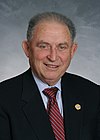| |||||||||||||||||||||||||||||||||||||
All 120 seats in the North Carolina House of Representatives 61 seats needed for a majority | |||||||||||||||||||||||||||||||||||||
|---|---|---|---|---|---|---|---|---|---|---|---|---|---|---|---|---|---|---|---|---|---|---|---|---|---|---|---|---|---|---|---|---|---|---|---|---|---|
| |||||||||||||||||||||||||||||||||||||
 Results: Democratic hold Democratic gain Republican hold Republican gain | |||||||||||||||||||||||||||||||||||||
| |||||||||||||||||||||||||||||||||||||
| Elections in North Carolina |
|---|
 |
An election was held on November 2, 2004 to elect all 120 members to North Carolina's House of Representatives. The election coincided with elections for other offices, including the Presidency, U.S Senate, Governorship, U.S. House of Representatives, Council of State, and state senate. The primary election was held on July 20, 2004 with a run-off occurring on August 17, 2004. These elections were the first to use new district lines drawn by the General Assembly to account the for changes in population amongst each of the districts after the 2000 census.[2] The 2002 elections had been conducted under a map ordered by the North Carolina Superior Court.[3]
Cite error: There are <ref group=lower-alpha> tags or {{efn}} templates on this page, but the references will not show without a {{reflist|group=lower-alpha}} template or {{notelist}} template (see the help page).
- ^ "Journal of The House of Representatives Of The 2003 General Assembly Of The State Of North Carolina First Session 2003 Volume 1" (PDF). Retrieved May 10, 2021.
- ^ "House Redistricting Plan" (PDF). Retrieved May 10, 2021.
- ^ "Interim House Redistricting Plan For N.C. 2002 Election" (PDF). Retrieved May 10, 2021.

